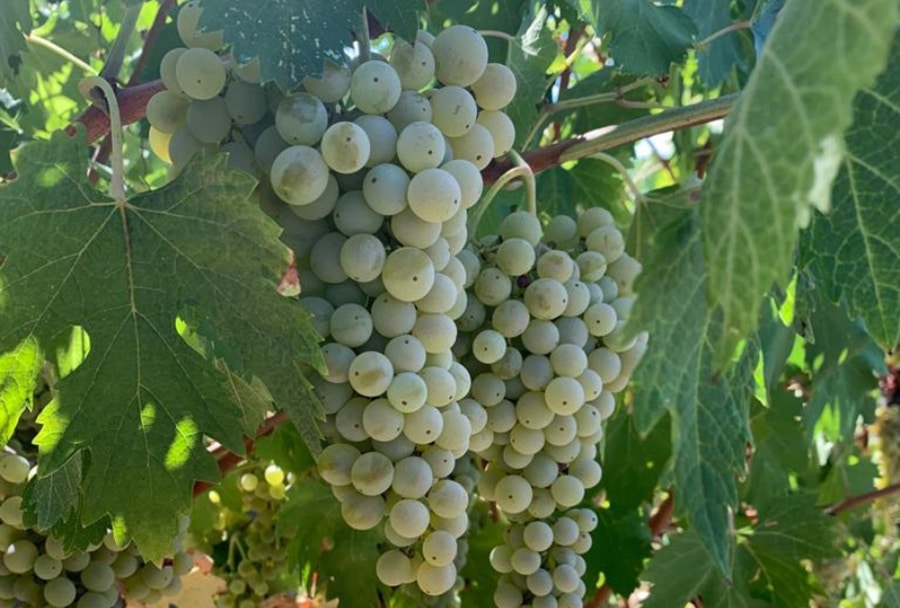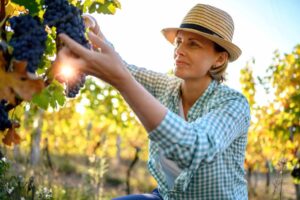Grechetto I.G:T. Montioni 2022: now available the new vintage
G r e c h e t t o I . G : T . M o n t i o n i 2 0 2 2 : n o w a v a i l a b l e t h e n e w v i n t a g e
Our new Grechetto 2022 is now available
The new Grechetto Montioni 2022 is ready to be savored during this summer 2023 starting from July 1st. Keep this date in mind, it’s very close!
While we wait for it to be available for purchase, we’ll tell you a little about its history and what you’ll find once your bottle of Grechetto IGT 2022 has been uncorked.
Summer 2022, as you will remember, was very dry here in Italy: the rains were slow to arrive and refresh our Umbrian territories. But the grapes from our vineyards proved to be strong and tenacious and after spending 4 months without water they reacted positively to the rains that arrived starting from the beginning of August.
After a fantastic strictly manual harvest during the first days of September, the Grechetto grapes are now ready to be tasted!



What does Grechetto IGT 2022 by Montioni look like?
Grechetto Montioni 2022 has aromas reminiscent of cedar, lime and vanilla notes.
On the palate there is a good acidity accompanied by a great freshness.
In short, Grechetto 2022 is the ideal wine for the hot summer ahead: enjoy it cool as an aperitif on the terrace with friends, accompanied by fish-based appetizers!
How Grechetto IGT is produced
Our young white wine is produced with 100% Grechetto grapes, a native vine typical of Umbria. Its bunches, once manually harvested in September during the harvest, undergo fermentation in steel and then spend three months of aging in steel and three months in the bottle.
Our Advice
We advise you to savor our Grechetto at a temperature of 10/12 degrees and to combine it with fresh cheeses, white meats and, of course, good fish!
Are you ready to taste it? To receive yout Grchetto Montioni 2022 directly at home and you live abroad please write as at: ordini@gabrielemontioni.it
On occasion, the winemaker may decide to leave them in if the grapes themselves contain less tannin than desired. This is more acceptable if the stems have ‘ripened’ and started to turn brown. If increased skin extraction is desired, a winemaker might choose to crush the grapes after destemming.
Wine is one of the most civilized things in the world and one of the most natural things of the world that has been brought to the greatest perfection, and it offers a greater range for enjoyment and appreciation than, possibly, any other purely sensory thing.
Ernest Hemingway Tweet
Removal of stems first means no stem tannin can be extracted. In these cases the grapes pass between two rollers which squeeze the grapes enough to separate the skin and pulp, but not so much as to cause excessive shearing or tearing of the skin tissues. In some cases, notably with “delicate” red varietals such as Pinot noir or Syrah, all or part of the grapes might be left uncrushed (called “whole berry”) to encourage the retention of fruity aromas through partial carbonic maceration.
The Grapes
The quality of the grapes determines the quality of the wine more than any other factor. Grape quality is affected by variety as well as weather during the growing season, soil minerals and acidity, time of harvest, and pruning method. The combination of these effects is often referred to as the grape’s terroir.
Grapes are usually harvested from the vineyard from early September until early November in the northern hemisphere, and mid February until early March in the southern hemisphere.
In some cool areas in the southern hemisphere, for example Tasmania, harvesting extends into May. The most common species of wine grape is Vitis Vinifera, which includes nearly all varieties of European origin. The most common species of wine grape is Vitis Vinifera, which includes nearly all varieties of European origin.

Manual harvesting is the hand-picking of grape clusters from the grapevines. In the United States, some grapes are picked into one- or two-ton bins for transport back to the winery. Manual harvesting has the advantage of using knowledgeable labor to not only pick the ripe clusters but also to leave behind the clusters that are not ripe or contain bunch rot or other defects. This can be an effective first line of defense to prevent inferior quality fruit from contaminating a lot or tank of wine.
Destemming is the process of separating stems from the grapes. Depending on the winemaking procedure, this process may be undertaken before crushing with the purpose of lowering the development of tannins and vegetal flavors in the resulting wine. Single berry harvesting, as is done with some German Trockenbeerenauslese, avoids this step altogether with the grapes being individually selected.
Crushing is the process when gently squeezing the berries and breaking the skins to start to liberate the contents of the berries. Destemming is the process of removing the grapes from the rachis (the stem which holds the grapes).
In traditional and smaller-scale wine making, the harvested grapes are sometimes crushed by trampling them barefoot or by the use of inexpensive small scale crushers. These can also destem at the same time. However, in larger wineries, a mechanical crusher/destemmer is used. The decision about destemming is different for red and white wine making. Generally when making white wine the fruit is only crushed, the stems are then placed in the press with the berries. The presence of stems in the mix facilitates pressing by allowing juice to flow past flattened skins.

Katerina Monroe
@katerinam • More Posts by Katerina
Congratulations on the award, it's well deserved! You guys definitely know what you're doing. Looking forward to my next visit to the winery!
